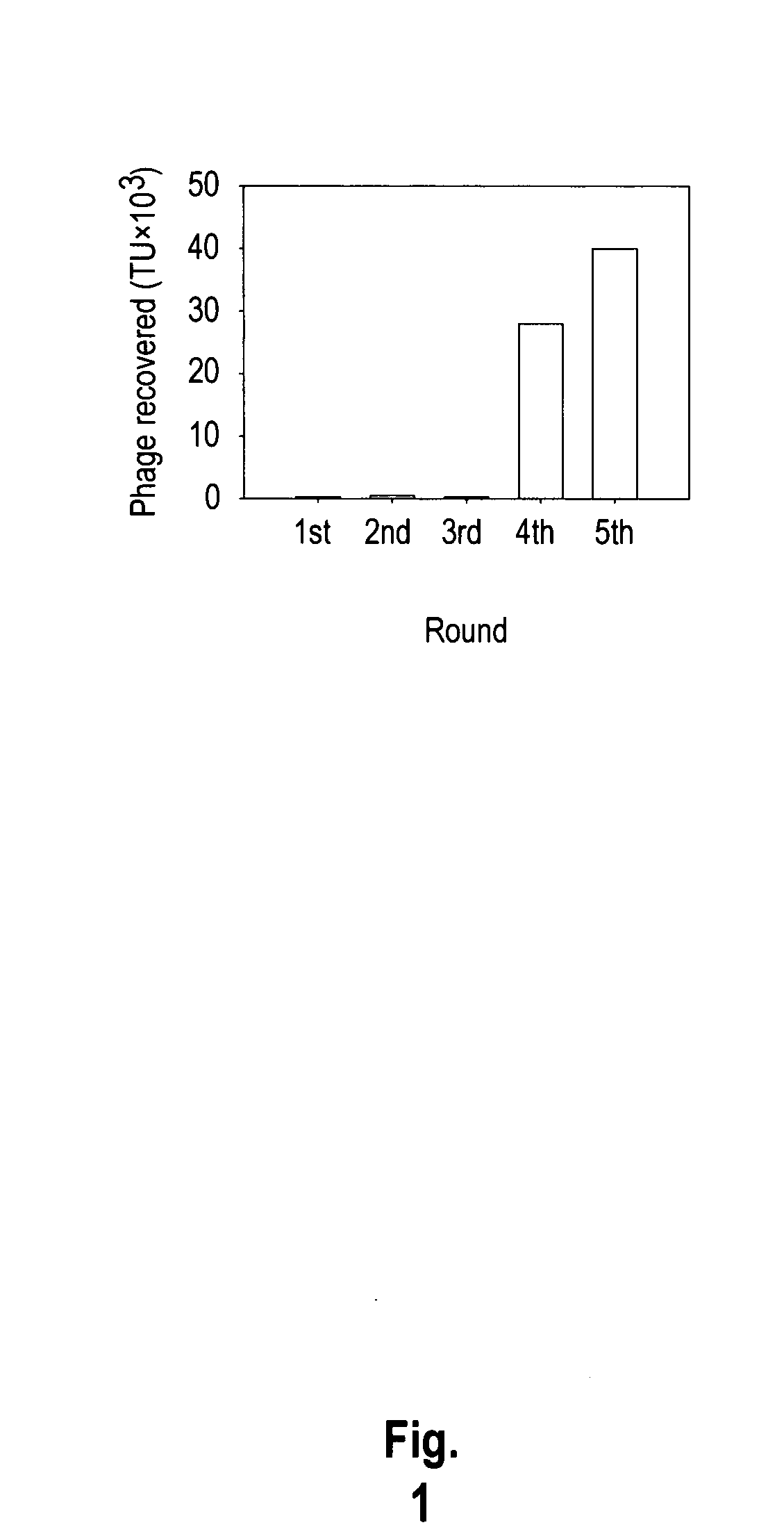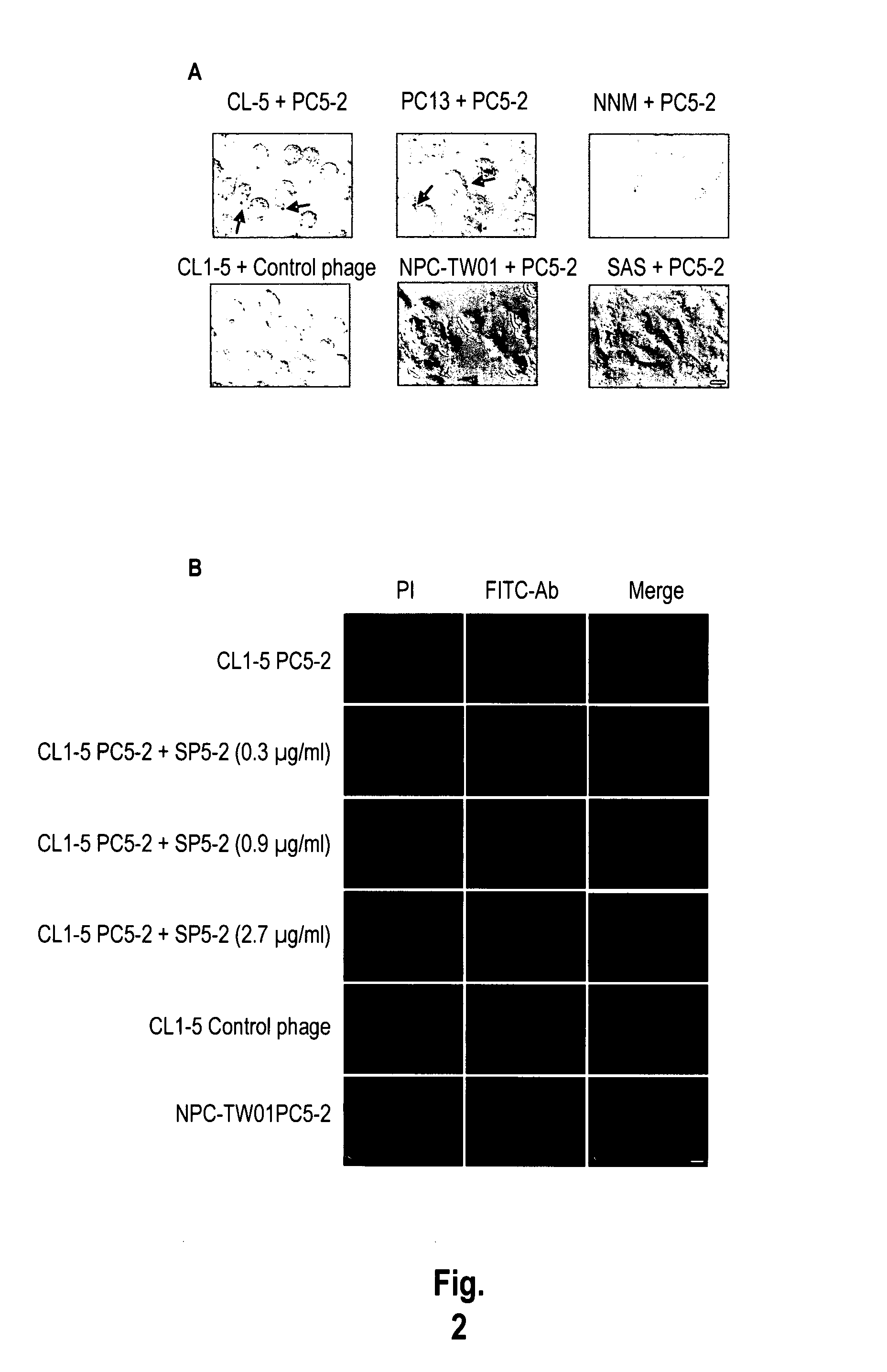Lung cancer-targeted peptides and applications thereof
- Summary
- Abstract
- Description
- Claims
- Application Information
AI Technical Summary
Benefits of technology
Problems solved by technology
Method used
Image
Examples
example 1
Phage-Display Biopanning
[0184]A549, CL1-5, H23, and H460 cells were grown in RPMI 1640 supplemented with 2 g bicarbonate, 40 mg kanamycin per liter, 2 mM L-glutamine, and 10% fetal bovine serum at 37° C. under a humidified atmosphere of 95% air and 5% CO2 (v / v). NPC-TW01, PC13, SAS, PaCa, NNM, and fibroblast were grown in DMEM containing 3.7 g bicarbonate, 40 mg kanamycin per liter, 2 mM L-glutamine, and 10% fetal bovine serum at 37° C. under a humidified atmosphere of 90% air and 10% CO2 (v / v).
[0185]NSCLC, CL1-5, cells were washed with the serum free RPMI and then blocked with blocking buffer (serum free RPMI containing 1% BSA) at 4° C. for 30 minutes. The cells were incubated with UV-treated inactive control helper phage (insertless phage) at 4° C. for 1 h. After inhibition of nonspecific binding, a phage displayed peptide library (New England BioLabs, Mass., USA) was added and incubated at 4° C. for 1 h. The bound phages were eluted with lysis buffer (150 mM NaCl, 50 mM Tris-HCl ...
example 2
Identification of the Phages Binding to Cancer Cells by Immunohistochemistry
[0190]To investigate whether PC5-2 could specifically bind to NSCLC cells, we used immunohistochemistry to localize the phage particles in different cell types. All cancer cell lines, NNM and fibroblasts were plated and grown to about 80% confluence on cover slips. The cover slips were incubated in the blocking buffer, treated with 1% hydrogen peroxide plus 0.1% NaN3 to block endogenous peroxidase activity, and then incubated with each selected phage at 4° C. for 1 h. The cover slips were washed and incubated with HRP-labeled mouse anti-M13 monoclonal antibody at 4° C. for 1 h. The slides were fixed with 3% formaldehyde for 10 min, and subjected to peroxidase substrate and mounted with 50% glycerol in PBS.
[0191]The results showed that PC5-2 bound specifically to NSCLC cell lines including CL1-5 and PC13 (FIG. 2A, arrows). The control helper phage, which did not display this peptide, could not bind to CL1-5 c...
example 3
Binding of Targeting Peptide with NSCLC Cells and Lung Cancer Biopsies
[0197]To determine if the peptide sequences displayed on the PC5-2 indeed interacted with the NSCLC cells, we used FITC-labeled SP5-2 peptide in place of the PC5-2 phage for a peptide-binding assay using immunofluorescent staining. The results showed that the FITC-labeled SP5-2 specifically bound to the different NSCLC cell lines including CL1-5, H460, A549, PC13 and H23, but not normal epithelial cells (NNM). The FITC-labeled control peptide revealed no such binding activity (FIG. 3A). Scale bar: 10 μm.
[0198]To further confirm FITC-labeled SP5-2 could bind to these NSCLC cell lines, we also measured SP5-2-bound cells using flow cytometry. Samples were prepared as in Example 2. Flow cytometry histograms show the FITC-labeled SP5-2 binding to each NSCLC cell line (blue) and the backgrounds of FITC-labeled control peptide (red). The ratio of binding activity for CL1-5, H460, A549, PC13 and H23 was 43%, 45.8%, 44.3%,...
PUM
| Property | Measurement | Unit |
|---|---|---|
| Chemotherapeutic properties | aaaaa | aaaaa |
Abstract
Description
Claims
Application Information
 Login to View More
Login to View More - R&D
- Intellectual Property
- Life Sciences
- Materials
- Tech Scout
- Unparalleled Data Quality
- Higher Quality Content
- 60% Fewer Hallucinations
Browse by: Latest US Patents, China's latest patents, Technical Efficacy Thesaurus, Application Domain, Technology Topic, Popular Technical Reports.
© 2025 PatSnap. All rights reserved.Legal|Privacy policy|Modern Slavery Act Transparency Statement|Sitemap|About US| Contact US: help@patsnap.com



